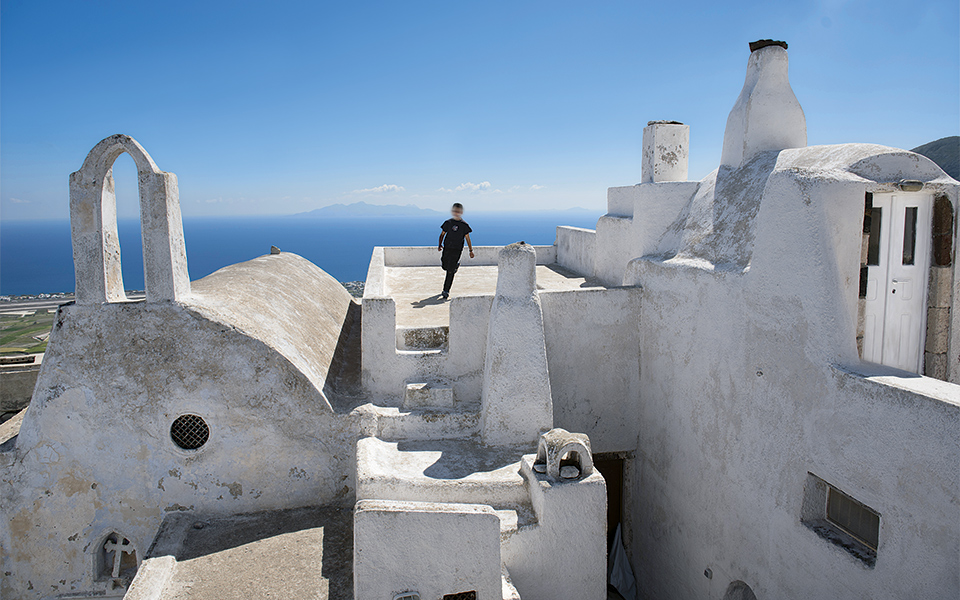Just seven and half kilometers south of Fira, a different side of Santorini emerges, an aspect that harkens back to the picturesque Greek villages of yesteryear. Here, the pace of life is more relaxed; cats stroll in the alleys, families dress up in their Sunday best to go to church, and piano lessons can be heard through the open windows of the cultural society. The main square, with its tall pine trees and quaint little coffee shops, is the focal point for socializing and entertainment. Regardless of the season, its busiest time is noon, when people gather for ouzo or Santorinian beer accompanied by excellent local meze.
This is Pyrgos, the largest preserved village on Santorini and the island’s former capital. Strategically built in the heart of the pre-volcanic hinterland and at the foot of Mt Profitis Ilias, Pyrgos affords panoramic views. Yet, located that bit further from the famous caldera, it has been spared the terraces, balconies, infinity pools and master suites that adorn the glossy covers of tourist magazines the world over. Pyrgos is not swamped by sunset spotters, nor is it the first choice among the hordes of cruise-ship passengers. Its charm is different: more subdued, less picture-perfect, little advertised.
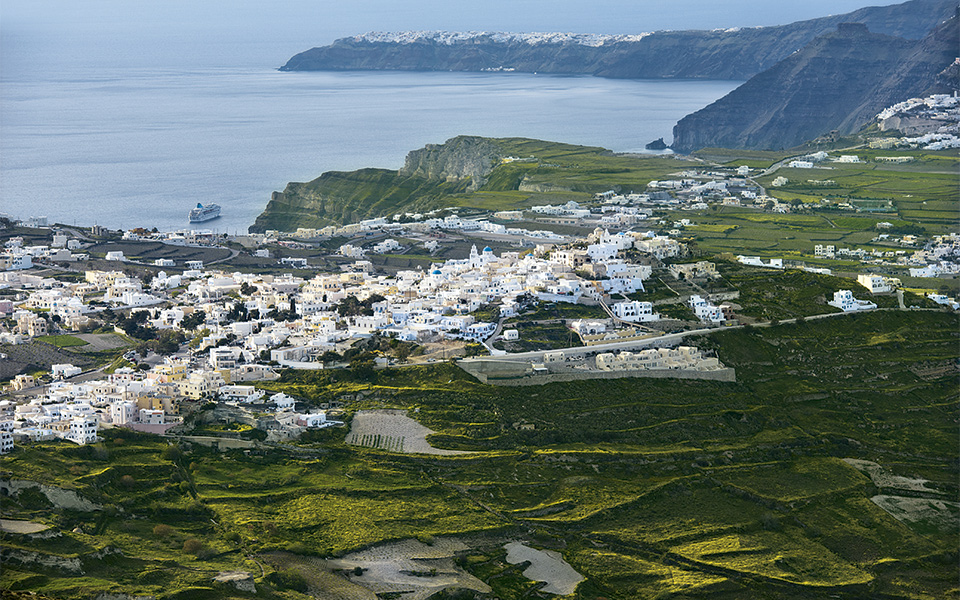
© Vangelis Zavos
Ask the locals what the difference is between Pyrgos and the rest of the island in terms of social profile, and you’ll get conflicting answers. For some, it’s that the villagers are more cultivated and more united among themselves, while for others, it’s that its location has kept the village relatively untouched – at least for now – by the tourist industry that is flourishing on the island.
It is a fact, however, that on Palm Sunday, as I was going up to the top of the medieval Kasteli (castle), I was overcome with emotion. The historic Church of the Presentation of the Virgin Mary (1660), one of Santorini’s largest and most important places of worship, was welcoming the faithful for the first time after a lengthy restoration: its masterful pulpit and intricate woodcarved altarpiece have been fully restored after centuries of wear and tear.
Shortly afterwards, a crowd of local people and friends of the island, including parents with their young children, rolled up their sleeves and cleaned the castle in preparation for Easter. Black plastic bags, disposable gloves and bottled water from the square were handed out as everybody worked in good spirits – mission accomplished!
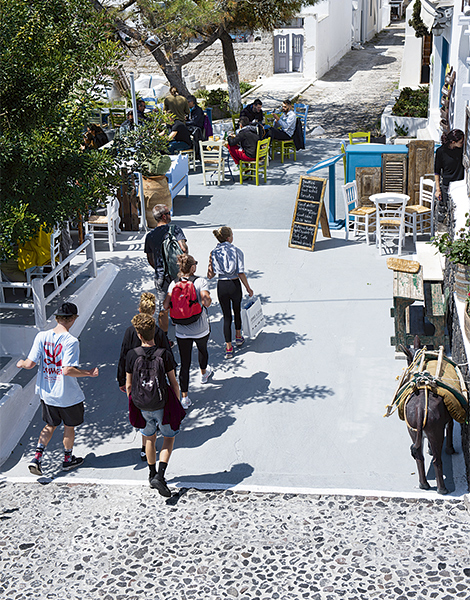
© Vangelis Zavos
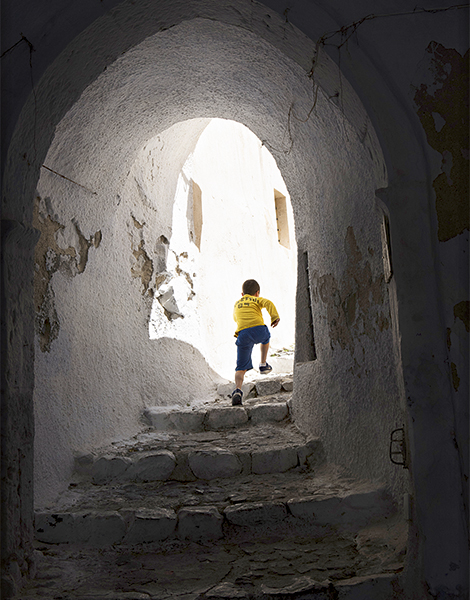
© Vangelis Zavos
“What we’re trying to instill in young people is the idea that only with love and affection for our land and its history, and with solidarity within the community, can we ever guarantee the future of the village and the preservation of its monuments and churches – all the things that attract visitors,” explained Giorgos Darzentas, president of the village council. “People in Pyrgos have not yet been corrupted by tourism money.
Our businesses are modest and down to earth, and people care about the environment and maintaining the architectural profile of the village. As much as we can, we avoid discord. All of us who are able, offer money, time and effort. Pyrgians love Pyrgos, and this becomes evident to our visitors.” Darzentas goes on to show me an intricate pebble mosaic that paves the yard in front of the church: “This too, we made with our hands.”
The local cultural society supports these civil efforts wholeheartedly. Founded in 1949 but later falling dormant for a number of years, the society has, under the leadership of its current president, Makis Zorzos, been rejuvenated and now hosts dozens of cultural events, while also offering dance, music and theater lessons to teenagers and young children.
“We operate an exhibition space and an information center on the main square, we manage the village library and historical archives, and we offer help to students who get into university.
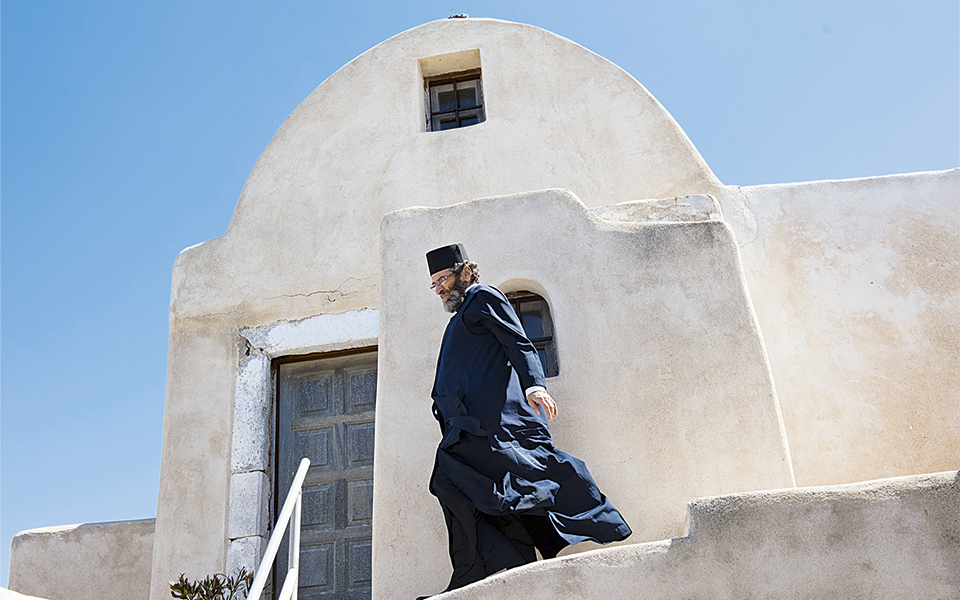
© Vangelis Zavos
All of this we do with our own funds and with donations from friends of the village.” His own two sons serve the common cause as well. Lefteris, who studied archaeology in London, runs the first-class Voreina Suites Hotel while simultaneously overseeing the digitization of Santorini’s historical and photographic archives. He also owns Crossroad, an antiques store and art gallery that is counted among the finest in the Cyclades. Vassilis, the other son, is an architect who undertakes new builds but also oversees restoration projects that respect the architectural identity of the area.
It is, however, only in the last ten years that – thanks to this nucleus of permanent residents and friends who are concerned about its medieval heritage – Pyrgos has embarked on the path of mild and controlled tourist development. Its most beautiful mansions, such as Villa Ioulia and Zannos Melathron – both built at the end of the 19th century by the rich ship owner and wine merchant Michalis Zannos – have been restored in exemplary fashion. Now operating as luxury accommodation, they offer their guests the atmosphere of a bygone era.

© Stylianos Papardelas
In 2010, Yiorgos Hatziyannakis – the first man to transform the island’s local produce into haute cuisine in the 1980s with his renowned Selene Restaurant in Fira – adopted Pyrgos as the base for both his gourmet restaurant Selene and its more casual sibling, Selene Meze & Wine. Another Fira legend followed suit.
Franco’s Bar, which made local history by providing perfect cocktails and classical music as an accompaniment to the famous caldera sunsets, now has a bird’s-eye view of the island from the vantage point of Pyrgos. The common denominators among these new establishments are balance and moderation. Aesthetic missteps have, for the most part, been avoided.
If you feel inclined to visit Pyrgos, get your climbing shoes on. This is the only way to explore the Pyrgos Kasteli, the best preserved of the five Venetian castles that once adorned the island. Don’t worry about getting lost; just head uphill from the main square and you’ll find it, a fortress hamlet that started life as a monastery and grew in size after the arrival of the Venetians at the beginning of the 13th century.
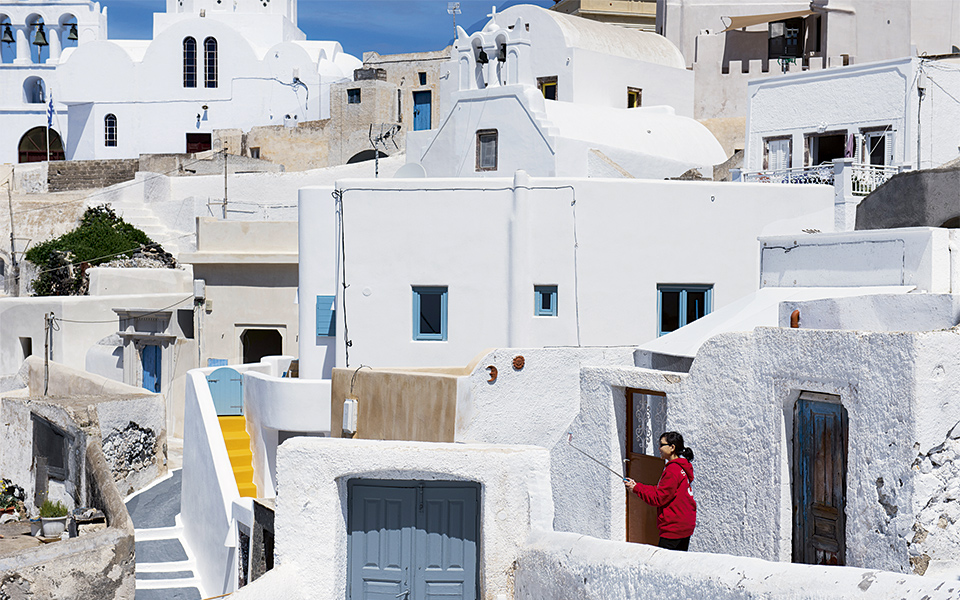
© Vangelis Zavos
It initially consisted of two- and three-story houses, wisely built into a dense, labyrinthine compound, with the outer walls forming a perimetric shield against pirate invasions. The one and only gate led to the interior, and a guard bolted the wooden-and-metal door shut at sunset. Over the door, there was a fonissa or murder-hole, through which hot water could be poured onto the heads of intruders.
When, with time, the risk of invasions diminished, the dwellings of the fortified perimeter dropped their guard, opening up windows, doors and liatika (sheltered balconies), and the original citadel began to expand beyond the walls of the castle, forming the Kseporto (literally, “outside the gate”).
Some villagers still remember living within the Kasteli, before the earthquake of 1956. One, an affable, nonagenarian lady who now lives in the new square of the village, introduces herself proudly as Maria the Kastelian.
“You couldn’t see the sky; it was all narrow, vaulted passages. On moonless nights, my aunt would carry an oil-lantern to light the way for us to visit our neighbors; that’s how we passed the time. We cooked in earthenware pots over wood fires, and the food tasted delicious because of it. Kastelians had it better than the rest; they called us nobles.”
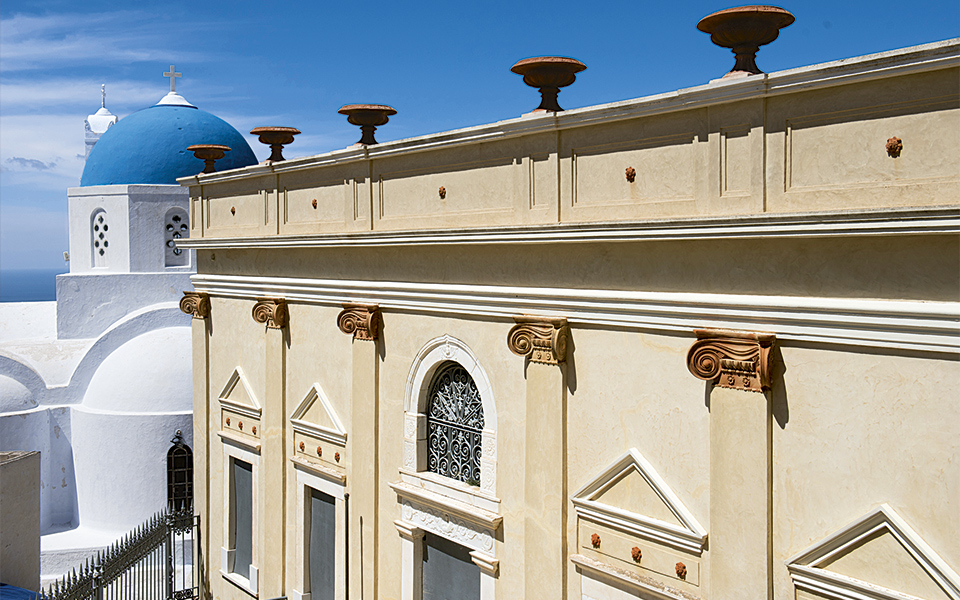
© Vangelis Zavos
The house where Maria grew up shared a wall with the Church of Aghios Iakovos, a vaulted structure dating from 1805. She can still remember to whom every house in Kasteli belonged. Her legs are too frail now to carry her up the 120 steps, but her living testimony is a mine of information for researchers of the area’s history.
Alterations inside the Kasteli, she explained, were carried out with great skill by real craftsmen who used mules to carry their materials. “When it rained, the water flowed into our yard to fill up our cistern, and then it would overflow into the gutter and spill into the street below – we never flooded. One house was next to or on top of the other. You could enter through one door and exit into the next street. The view from the roof was of vineyards, nothing else. Now, it’s only houses. All the villages have become one big town. At night when they’re lit up, I feel like I’m in Athens.”
Pyrgos, like the rest of Santorini, changed radically after the earthquake of 1956. Puzzlingly, the Kasteli, because of the calcareous soil it sits on, did not suffer much damage in the quake itself. When, however, the civil engineers came to inspect the buildings, many sound houses were condemned purely for financial reasons. Upper floors were knocked down, filling the ground floor with rubble. In some cases, they even used cement to stabilize the remains. Homeowners sold properties for a pittance or abandoned them, and moved into the new homes that were built for them on the lower outskirts of the village in an undertaking that changed the shape of Pyrgos.
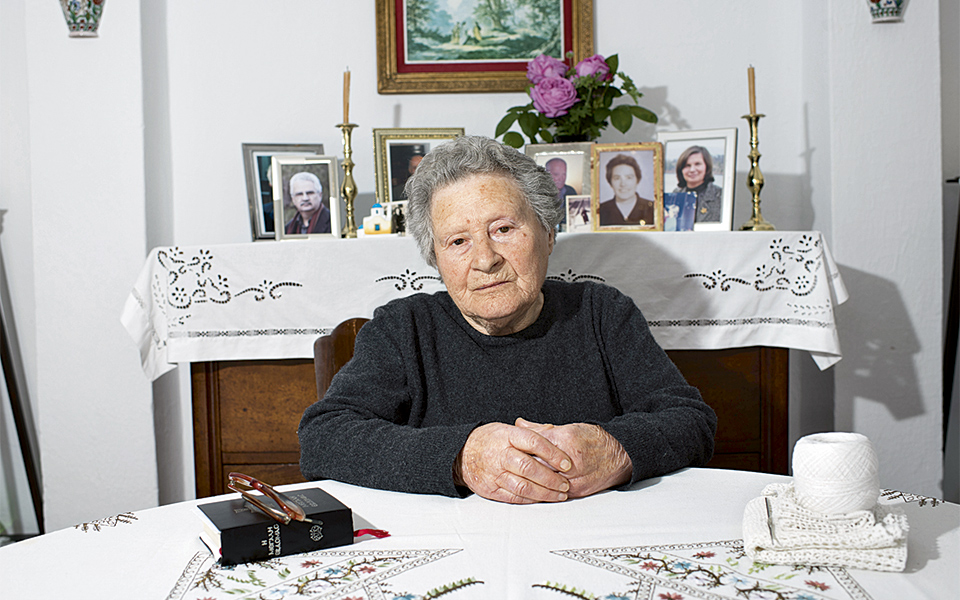
© Vangelis Zavos
Despite these modifications, Pyrgos still has a lot to offer. There are small galleries, such as Kallisti, boutique cafés like Kasteli 1663 (with its homemade desserts and permanent exhibition of black-and-white photographs), and elegant restaurants. The Church of Aghios Nikolaos, with its square, draws visitors, as does the little museum of icons and church relics (including a rare icon of St George from the early 15th century) housed in the church of Aghia Triada.
There’s even a chance you might meet Father Michail, who can let you into the Theotokaki – a tiny, 14th-century chapel under restoration at the north end of the Kasteli which, in its original form, could barely fit four or five worshippers. The natural light streaming through the only door will illuminate the unique altarpiece and make your elated soul rejoice when, for a few precious seconds, you become privy to this well-hidden gem in the mega-destination known as Santorini.

